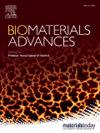Mechanically robust, mouldable, dynamically crosslinked hydrogel flap with multiple functionalities for accelerated deep skin wound healing
IF 5.5
2区 医学
Q2 MATERIALS SCIENCE, BIOMATERIALS
Materials Science & Engineering C-Materials for Biological Applications
Pub Date : 2025-01-20
DOI:10.1016/j.bioadv.2025.214195
引用次数: 0
Abstract
Deep cutaneous wounds, which are difficult to heal and specifically occur on dynamic body surfaces, remain a substantial healthcare challenge in clinical practice because of multiple underlying factors, including excessive reactive oxygen species, potential bacterial infection, and extensive degradation of the extracellular matrix (ECM) which further leads to the progressive deterioration of the wound microenvironment. Any available individual wound therapy, such as antibiotic-loaded cotton gauze, cannot address all these issues. Engineering an advanced multifunctional wound dressing is the current need to promote the overall healing process of such wounds. Here, we report a multifunctional hydrogel flap primarily composed of biodegradable polymers gelatin (G) and poly-methyl vinyl ether-alt-maleic acid (MA) as the base material. The hydrogel physically incorporates tannic acid (TA) and vancomycin (V), for added functionality. The resulting hydrogel flap, gelatin- poly-methyl vinyl ether-alt-maleic acid-tannic acid-vancomycin (G-MA-TA-V/E-N), is formed through a chemical crosslinking process using EDC (E) and NHS (N). Thus, the hydrogel flap reveals multiple ideal properties that support its ease of application, including stretchability, porous microstructure (honey-comb structure), mouldability, and adhesiveness to multiple surfaces, including wet biological surfaces. The in vitro studies demonstrated strong antioxidant, antibacterial, and absorption properties essential for accelerated wound-healing applications. In vivo studies further reveal accelerated wound contraction and enhanced healing kinetics, promoting re-epithelialization, angiogenesis, and formation of apocrine glands. These findings underscore the efficacy and cost-effectiveness of fabricated hydrogel flaps as viable therapeutic options for treating deep skin wounds and make it worthwhile to integrate them with medical devices for tissue adhesion.
求助全文
约1分钟内获得全文
求助全文
来源期刊
CiteScore
17.80
自引率
0.00%
发文量
501
审稿时长
27 days
期刊介绍:
Biomaterials Advances, previously known as Materials Science and Engineering: C-Materials for Biological Applications (P-ISSN: 0928-4931, E-ISSN: 1873-0191). Includes topics at the interface of the biomedical sciences and materials engineering. These topics include:
• Bioinspired and biomimetic materials for medical applications
• Materials of biological origin for medical applications
• Materials for "active" medical applications
• Self-assembling and self-healing materials for medical applications
• "Smart" (i.e., stimulus-response) materials for medical applications
• Ceramic, metallic, polymeric, and composite materials for medical applications
• Materials for in vivo sensing
• Materials for in vivo imaging
• Materials for delivery of pharmacologic agents and vaccines
• Novel approaches for characterizing and modeling materials for medical applications
Manuscripts on biological topics without a materials science component, or manuscripts on materials science without biological applications, will not be considered for publication in Materials Science and Engineering C. New submissions are first assessed for language, scope and originality (plagiarism check) and can be desk rejected before review if they need English language improvements, are out of scope or present excessive duplication with published sources.
Biomaterials Advances sits within Elsevier''s biomaterials science portfolio alongside Biomaterials, Materials Today Bio and Biomaterials and Biosystems. As part of the broader Materials Today family, Biomaterials Advances offers authors rigorous peer review, rapid decisions, and high visibility. We look forward to receiving your submissions!

 求助内容:
求助内容: 应助结果提醒方式:
应助结果提醒方式:


